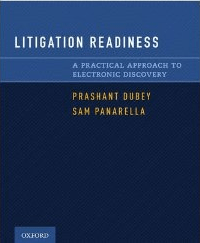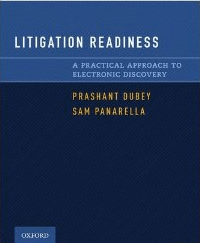ARCHIVED CONTENT
You are viewing ARCHIVED CONTENT released online between 1 April 2010 and 24 August 2018 or content that has been selectively archived and is no longer active. Content in this archive is NOT UPDATED, and links may not function.Taken from the recently published book Litigation Readiness: A Practical Approach to Electronic Discovery* by Prashant Dubey** and Sam Panarella***, the following extract on FRCP Rule 26(f) conference preparation provides an excellent overview of the practical steps necessary for “Meet and Confer” conference success.
Steps to 26(f) Success
9.11. STEPS TO 26(F) SUCCESS
Clients can prepare for the FRCP Rule 26(f) conference by developing an understanding of the following:
- Preservation processes: How are legal holds enforced and documented? Have preservation obligations for the matter been met? What voluntary disclosures are required as part of the 26(f)?
- Content repository analysis: What data repositories contain potentially responsive electronically stored information (ESI)? How accessible are they? What systems are in place for identifying potentially relevant content?
- Total cost of e-discovery analysis: What is the likely total cost of e-discovery for the matter? What resources will be required to respond to potential discovery requests?
- Accessibility analysis: Where does ESI exist within the company? How accessible is the data for discovery? What are the areas of greatest potential undue burden or cost? What is the basis for arguments, if available, to claim inaccessibility due to undue burden or cost?
- Collection methodologies: What are the available collection protocols as they relate to existing computer systems? Which approaches are best, both in terms of cost and defensibility, for the matter at hand? What documentation exists to demonstrate reasonable design of the process?
- Production format recommendations: What are the different methods of production that are likely to be pertinent to the case? Which ones can the company best support?
Following is a step-by-step breakdown of how the Discovery Response Plan is applied to the meet-and-confer conference.
Step 1: Complaint Served
- Document the date complaint was received
- Identify potentially relevant custodians and data repositories
Step 2: Litigation Hold/Preservation Process
- Information technology (IT), legal, and records management staff meet and discuss legal hold approach
- Issue legal hold notice to all custodians, including IT stewards of relevant data repositories
- Reconfirm that all appropriate destruction policies have been suspended
- Identify IT owner for evidence preservation effort (aka person most knowledgeable)
- Meet with key custodians to ensure compliance with legal hold
- Collect and preserve potentially relevant evidence (in place or in secure evidence repository)
Step 3: Early Case Planning
- Gather existing documentation and assign tasks for mandatory disclosure
- Collect and review subset of key custodians/types
- Test search term, sampling, and other culling custodian strategies
- Extrapolate findings to determine potential costs and timeline implications of your strategies and for those requests that may be presented at the meet-and-confer
Step 4: Early Discussions
- Formulate a cost-effective yet fair scope of discovery:
- Number of relevant custodians
- File types and locations
- Accessible versus inaccessible ESI
- Format of production
- Reasonable time frame
- Create a record of actions and decisions taken in good faith
- Maximize cost-shifting opportunities
- Solidify preservation, privilege, and reduction strategies
Step 5: The Initial Meeting
- Bring with you:
- Content map
- Budgeting information
- All backup documentation
- Expert who is knowledgeable about the entire electronic discovery process
- Blank calendar for on-site planning
- Have some low exposure, low-cost items to use during the negotiation
- Control your own destiny, if you can, by coming to an agreement
- Promise only what you are certain you can deliver.
* Used by permission of Oxford University Press.
About the Authors
**Prashant Dubey is CEO of The Sumati Group. Previously, he was CEO and co-founder of The Knott Group. Prashant has been a senior operating executive at public and private corporations, such as Baxter International, Fios, ABC Technologies, Tripwire and Covansys, taking many of them to and through successful exits that have yielded high returns for investors. He introduced the concept of Litigation Readiness to the market in 2003 and has authored dozens of articles on the subject. He holds a BA in Economics from the University of Chicago and an MBA in Strategy from the University of Chicago, Booth School of Business.
***Sam Panarella is the CEO of Crux Consulting. Sam founded Crux Consulting after many years spent counseling large companies, first for a decade as a partner with a major western law firm, then as the executive in charge of the consulting operations at two national companies. Sam was selected by his peers for inclusion in the 2007 edition of The Best Lawyers in America. As a lawyer with a strong business process focus and technical aptitude, Sam understands both the nuts and bolts of how lawyers and legal divisions do their work and the cost and risk mitigation that is possible through the thoughtful application of business process rigor.
Buy the complete work on Litigation Readiness: A Practical Approach to Electronic Discovery on Amazon.com @ http://www.amazon.com/Litigation-Readiness-Practical-Electronic-Discovery/dp/0195384075























